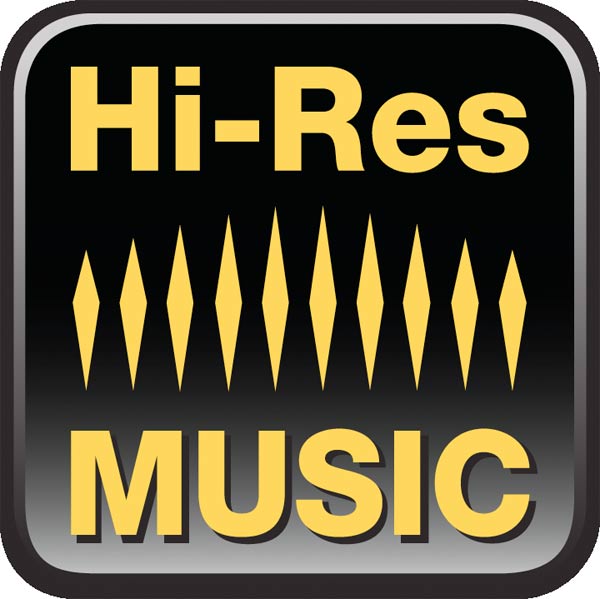The RIAA Introduces Hi-Res MUSIC Logo
I heard about this announcement yesterday at the CE Week conference…and it certainly sounded encouraging. The RIAA (Recording Industry Association of America) “and its member companies today unveiled a new logo designed to help music fans more easily identify the highest-quality digital music. This significant step forward in the digital listening experience allows digital retailers to mark recordings that meet the official definition for ‘High Resolution Music’ that was agreed to last year, in cooperation with the Consumer Electronics Association, DEG: The Digital Entertainment Group and The Recording Academy Producers & Engineers Wing.” [NOTE: The definition they issued referred to “high-resolution audio” NOT music.]
The recording industry now has their own logo for identifying the “highest-quality” music being offered through digital retailers. They have adopted the terms “Hi-Res MUSIC” instead of “Hi-Res Audio”, which has been widely used over the past year. Do we really need two ways of describing the same thing each with their own logo?
Here’s the new logo:
Figure 1 – The new Hi-Res MUSIC logo developed by B2 Communications for the RIAA.
The new design doesn’t have the style and elegance of the JAS logo, which was produced by Sony. I’m honestly surprised that the RIAA found this design compelling…but that’s just my opinion.
According to the report that I found last evening, the new logo “was designed to identify those high resolution recordings that are available from digital music retailers in the U.S., Canada, and Europe for commercial downloads or streaming. The logo has been specifically designed to complement the Hi-Res AUDIO logo that is currently licensed by the Japan Audio Society for use on compatible consumer electronics devices.”
How does having two independent logos “complement” an already confused message about what is and what isn’t high-res. In one case we have a very high quality bar for the gear that plays “hi-res audio” and in the other we talk about the “highest-quality” music. Perhaps the logo should have used the terms “highest-res available MUSIC” since essentially nothing has changed.
Here’s the existing JAS logo:
Figure 2 – The JAS High-Res Audio Logo, which applies to hardware only.
The official definition of high-resolution music has morphed since its initial introduction about a year ago.
“High Resolution Music is officially defined as ‘lossless audio capable of reproducing the full spectrum of sound from recordings which have been mastered from better than CD quality (48kHz/20-bit or higher) music sources which represent what the artists, producers and engineers originally intended.”
The press release from the RIAA (You can read it yourself by clicking here) doesn’t mention the four descriptors that accompanied the original definition. And they’ve added the “artists, producers, and engineers originally intended” and the specification of “48 kHz/20-bit or higher”.
I can’t help but wonder why this new logo is being introduced when the existing JAS logo was already being used for both hardware and content. The RIAA announcement does state that the JAS logo is “for use on compatible consumer electronics devices”. Perhaps the JAS changed its mind after the Qobuz site adopted the logo and became a “certified” source for high-resolution audio. Or maybe the JAS realized that a single logo with two drastically different sets of requirements wasn’t a good idea.
So all of the standard-resolution recordings being sold or streamed just got a new logo. And the new logo incorrectly identifies them absolutely as “hi-res MUSIC”, when the press release itself says they are the “highest-quality” digital music, a relative measure not a hard specification driven standard.
Has the new logo helped clarify HRA…sorry, I guess I’m going to have to change the acronym to HRM now. You bet, we’re definitely on the right track to creating a clear and unified message.




This is great news. True HRA can still use the JAS logo. Those who know or care will know what that means. The remaining music – that has had some “care” can be called HRM. Not too bad. The NIN and Movie examples – 48 kHz/24-bit – rule. As a result an HRA/HRM world is the best we could have expected. This is a big win for audiophiles. I wish I’d had thought of it.
Remember, don’t let the best be the enemy of the better.
Dennis, I don’t agree that having two logos for the same concept is a positive step. The split between hardware (but not exclusively) and content is unfortunate. It happened because the JAS flip flopped. More information to come.
I don’t need any logos – just tell me the origin of the recording!
We should get a single message, which includes branding and information. We certainly don’t need the lame logo that B2 Communications designed.
Amazing how things come full circle.
This development does point strongly to what folks actually want regardless of labels, politics, financial aspects and on and on. They simply want to know that they are getting the very best possible iteration of their favorite music.
As I wrote sometime back, this whole mess could have easily avoided if the term(s) hi-res had never been coined as a label, and the correct terminology ,i.e.,., “First Gen Sound” had been used as an all-embracing term, allowing the consumer to avoid confusion and easily head for far better music experiences, master-tape grade audio transfers from B.C to A.D. so to speak. If hi-res is going to matter at all,it needs to be far easier to access and stand under one umbrella only. When consumers are confused or off-put, they do nothing but keep going down the same old road.
This development is all about politics and confusion between the various parties involved. The CEA was going to handle the licensing of the logo for the US…the JAS logo. But the JAS allows upconversion and a dual set of requirements for the logo…bad idea. So the major label’s trade association, the RIAA, came up with their own but adhered to the lower standard.
“High Resolution Music is officially defined as ‘lossless audio capable of reproducing the full spectrum of sound from recordings which have been mastered from better than CD quality (48kHz/20-bit or higher) music sources which represent what the artists, producers and engineers originally intended.”
Am I reading this right, as to finally exclude analog tape or anything other than a 48/20 or better digital recording as not qualifying for the HRM logo? Is this finally a win for HR digital provenance?
No, unfortunately it’s not. I attended the Sony event last night at Battery Studios. A very interesting and informative event. The head of Sony’s catalog referred to the projects they do (Elvis, Frank Sinatra etc) as “high-resolution transfers”. I like it. They are the best representation of older analog standard def source that are revived, restored, retransferred, and very carefully made available for the public. They’re the highest fidelity available…not high-resolution music but I might be able to get used to “high-res transfers”.
Sorry Mark but I just don’t buy that. CD’s are more than capable of delivering SQ that completely reproduces what is on those 40 year old analog masters.
“They are the best representation of older analog standard def source that are revived, restored, retransferred, and very carefully made available for the public”
This is what MFSL, Stan Ricker, Doug Sax and others were doing back in the day and IMHO it just won’t get any better than most of what they did with the old analog recordings. Sure we could use a lot more of that to get the very best archive copies of this great catalog of older music. Just don’t call it High anything.
We need a Logo that tells us that this release is a new recording done on digital equipment of an agreed to sampling speed that will deliver true HDA playback. Stand behind the provenance issue, if it came from a analog tape master it’s NOT and can never be HD
The rest of all this jabber is just discussing new ways to get people to again purchase the old catalogs.
I thinking they should be labeled “High-Res Transfers”…the term was used during the sessions at Battery Studios on Wednesday night. I like it.
Hi Mark,
I have to disagree with the use of a name like “High Resolution Transfer”. While accurately described, I think it would only add to the confusion of the masses, and the uninformed public will feel as if their wallets had (once again) been “digitally remastered” out of anothet $35. I think the words “high” & “resolution” as well as any other terms like “HD”, need to be distanced from any recordings that aren’t. Your demands upon the industry for reasosonable standards & provenance are the best thing to happen to music since the hi-fi. Let’s not muddy the waters more than it already is, even for the audio enthusiasts and audiophiles whom haven’t been reading your posts & have been mislead by many. .
Bruce, it’s real challenge. The parties that are controlling the logos, definitions, promotion, and “Guidelines” for consumers and producers are going with high-res. There is virtually no chance of them moving away from high-res. So I’m trying to get them to at least be accurate about what a consumer purchases. If the original source was standard definition analog then using “high-res transfer” might pass muster for all concerned. I would be willing accept High-Res XFR, if they are accurate in using a new logo and spreading the word about the difference between older recording transferred and new high-resolution tracks.
It may be time to get what we can get and move on.
Wow, how are you not driven insane by the stupidity and greed shown by the “recording” and high end audio industry? Don’t you just want to retire and conclude you fought the good fight but it’s the next generations turn to move audio technology forward honestly? You are a stronger person than many! acta est fabula plaudite!
I think we’re making slow progress. I’ve met a lot of new press people due to the CE Week events and feel that we can get a message out that mattes. There might even be room for the major players to buy in…stay tuned.
Mark, the new Hi-Res Music logo may lack the style and elegance of the Hi-Res Audio logo, but there is a certain elegance to the way it takes that all too standard stair step bar chart graphic and by replacing the bars (rectangles) with kites it loses the stair steps.
I can’t see it…not a great design.